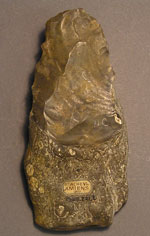Old Stone Age
The term 'Stone Age' is used by archaeologists to describe the prehistoric period when humans utilised stone and flint to produce edged tools. A division of the Stone Age into Old and New was first proposed by Jens Jacob Worsaae in 1859. The sub-divisions Palaeolithic (old), Mesolithic (middle) and Neolithic (new) (lithic means stone), were first suggested by John Lubbock in his book Prehistoric Times, written in 1865. These terms are still used today. The transition out of the Neolithic age into the Bronze Age occurred between 6000 BC and 2500 BC in North Africa, Asia and Europe. It was a long gradual process, during which tools of stone and of bronze (copper and tin alloy) were used side by side. It was through the discovery of stone tools made by man, in association with remains of long-extinct fauna, that archaeologists began to realise the great antiquity of man, far greater than previously thought. Evans and Prestwich authenticated this proposition after examining discoveries made by Boucher de Perthes in the Somme gravels in 1859. John Evans was intensely interested in stone tools and collected a large quantity from countries across the world as well as the British Isles. The vast collection of these objects were given to the Ashmolean Museum by his son Arthur Evans, but some of the stone tools from Africa, Asia and America were subsequently presented to the Pitt Rivers Museum. |
This flint handaxe dates from the Lower Palaeolithic (c. 350,000-400,000 years ago); it is from the same discovery investigated by Sir John Evans at the St Acheul quarry, Amiens (Somme) in France. The collection from this site was presented to the Ashmolean by Sir Arthur Evans in 1928. |
Further References / Links:John Lubbock, Prehistoric Times, 1865 See also the chapter by Alison Roberts and Nick Barton in Sir John Evans 1823-1908, edited by Arthur MacGregor (2008) |

